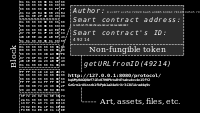
Photo from wikipedia
One of the features of the Bitcoin network today is that its participating nodes are located in different regions of the world. Generally, inter-region data transmission is relatively time-consuming compared… Click to show full abstract
One of the features of the Bitcoin network today is that its participating nodes are located in different regions of the world. Generally, inter-region data transmission is relatively time-consuming compared with intra-region data transmission. Thus, an important challenge for a blockchain network is shortening the block propagation time in order to reduce forks and maintain fairness, i.e., similar mining durations, for all miners. Previous methods have tried to increase the block propagation speed at the expense of imposing a higher burden on each node and a higher risk of eclipse attack. This paper proposes a new neighbor selection method that is based on only the neighbor’s regional information and assumes that a node has a relatively small number of neighbors located outside its region. By using this simple method, the distribution of blocks throughout the network becomes faster and the random neighbor-selection nature of the blockchain network is kept intact; thus, risk of an eclipse attack is low. This paper also proposes a block propagation model over multiple regions for exploring the theoretical reasons for the effectiveness of the proposed neighbor selection method. Finally, it examines a migration scenario to the proposed method from the default neighbor selection method implemented in Bitcoin nodes, and evaluates the migration effects in various sizes of networks.
Journal Title: IEEE Access
Year Published: 2022
Link to full text (if available)
Share on Social Media: Sign Up to like & get
recommendations!